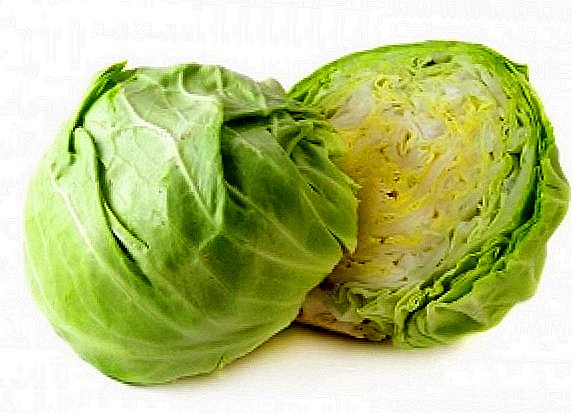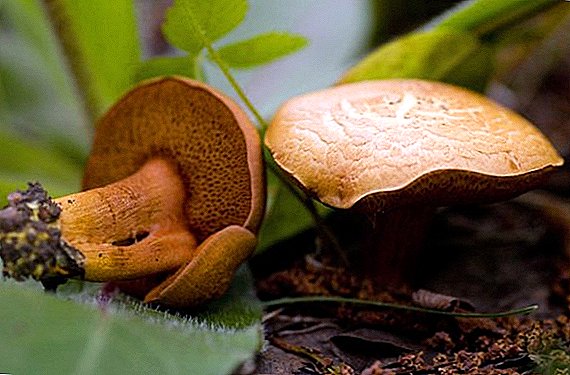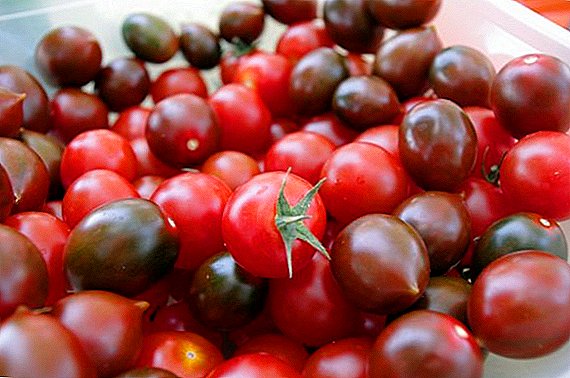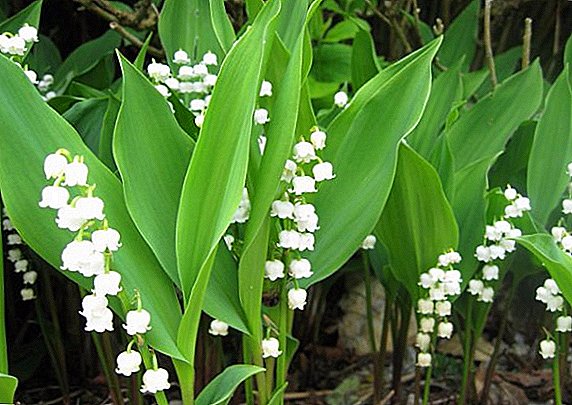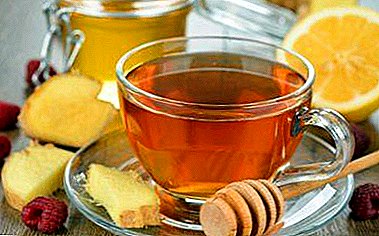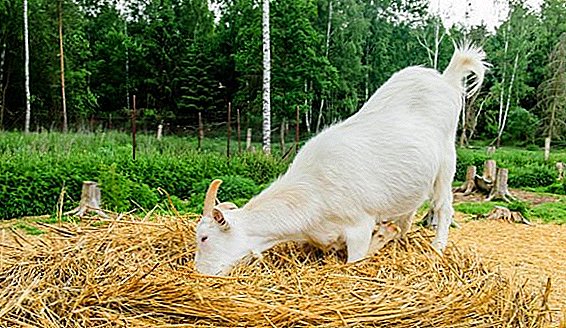 Indian onions have nothing to do with onions or leeks. This is one of the national names of ornithogalyum ("poultry lamb", "bird's milk"). This plant is quite common (has more than 150 species) and grows on different continents (including in temperate latitudes). According to traditional medicine, two types of poultry meat have healing properties: houseplants - bird tail and garden - umbrella bird
Indian onions have nothing to do with onions or leeks. This is one of the national names of ornithogalyum ("poultry lamb", "bird's milk"). This plant is quite common (has more than 150 species) and grows on different continents (including in temperate latitudes). According to traditional medicine, two types of poultry meat have healing properties: houseplants - bird tail and garden - umbrella bird
Did you know? It is known that the name "Indian onion" first appeared after 1961, when the seeds of tailed ornithogum from West Germany were brought to the USSR. There this plant is called the "dairy star", in England - the "Bethlehem star". The origin of the name "Indian onion" is unclear. Perhaps, it is given by analogy with the names "Chinese onion" or "Mongolian onion", which was called the umbrella ornithogum growing in Siberia. And perhaps, this plant with its bitter juice reminded someone burning Indian spices. One way or another, this name stuck and is used along with some others, such as “branka”, “squill”, etc.
The composition and therapeutic properties of Indian onions
It is known that ornithohalum is literally stuffed with biologically active substances.
Indian onion has a high content:
- essential oils;
- glycosides;
- organic acids;
- trace elements
- amino acids.
 Biologically active substances inhibit pathogenic bacteria, stop inflammation, increase blood circulation and lymph movement, thin the blood. The impact is primarily on the peripheral circulatory system. These properties are especially useful in the treatment of bruises and bruises, herpes, furunculosis, neuralgia, wound healing.
Biologically active substances inhibit pathogenic bacteria, stop inflammation, increase blood circulation and lymph movement, thin the blood. The impact is primarily on the peripheral circulatory system. These properties are especially useful in the treatment of bruises and bruises, herpes, furunculosis, neuralgia, wound healing.
The benefits of Indian onions for the body depends on which of these substances and how will be involved in the treatment. Therapeutic effects have alkaloids:
- colchicine - relieves pain, does not allow uric acid crystals to accumulate, acts as an anti-inflammatory agent (from side effects - diarrhea, nausea). This alkaloid is used in the treatment of gouty arthritis. Its toxicity is very high;
- Kolhamin - less toxic, it is actively used in the treatment of skin cancer (in the form of an ointment based on it), and is also part of other anti-cancer drugs;
Did you know? The question of what an Indian onion is and what its origin is is also confused and foggy, as is the question with the name. A single point of view about the origin of the plant "Indian onion" does not exist. According to one version, he comes from South Africa, on the other - from South America. There are views on ornitho gum as an autochthonous Mediterranean plant. Nevertheless, by the middle of the XIX century the plant was widely settled and settled down in Europe. Here it became perceived by many as a symbol of the home. For example, during World War II, German soldiers, before being sent to the Eastern Front, took in the form of an amulet “dairy star” bulbs.
Use in traditional medicine: how to be treated with Indian onions
 Indian onions, turned into a houseplant, has not lost the biologically active properties of their "wild" relatives (although made them softer and more usable). What Indian onions helps with, heals and umbrella poultice growing in the garden, but it has a much higher concentration of alkaloids and other substances and is mainly used for the preparation of medicinal raw materials.
Indian onions, turned into a houseplant, has not lost the biologically active properties of their "wild" relatives (although made them softer and more usable). What Indian onions helps with, heals and umbrella poultice growing in the garden, but it has a much higher concentration of alkaloids and other substances and is mainly used for the preparation of medicinal raw materials.
Important! Indian onions - a poisonous plant. It should refrain from the internal intake in its pure form of its juice. When using it externally, it must be remembered that each organism reacts to a particular drug differently, which is harmless for one - may cause an allergic reaction in another. Before use, it is important to test the drug in a small area of the delicate skin (back of the hand, inner elbow).
Broths, tinctures, ointments are prepared for use in medicinal purposes from Indian onions.
Headache
 Indian onions find their use as a remedy for headaches. If pain occurs, rub a few drops of plant juice (with light massaging movements). in the area of:
Indian onions find their use as a remedy for headaches. If pain occurs, rub a few drops of plant juice (with light massaging movements). in the area of:
- temples;
- the back of the head;
- neck and collar area (pain may be caused by cramps in the neck muscles).
If you feel a strong burning sensation, lubricate with olive oil or cream.
Toothache
 For toothache or inflammatory processes in the gums to remove inflammation and pain will help water mixture of soda and infusion of Indian onions.
For toothache or inflammatory processes in the gums to remove inflammation and pain will help water mixture of soda and infusion of Indian onions.
A glass of hot water is required for a teaspoon of soda and infusion. The cotton wool soaked in the solution should be applied to the diseased gum. It is not worth smearing the gums with fresh juice of Indian onion - it is poisonous and burns mucous membranes.
Runny nose
Indian onions are used in traditional medicine for relieving symptoms of rhinitis. It is important to apply the remedy when the first signs of the disease appear. Soft movements should rub a small amount of freshly squeezed Indian onion juice into the nose and the outer part of the wings of the nose. It is necessary to use means no more than three days (in the morning, during the lunchtime and in the evening).
Important! If Indian onion juice accidentally gets into your eyes, you must rinse them with plenty of running water, drip the taufon.
Angina, tonsillitis

Gargling with broths or infusions of Indian onions with treating sore throat or tonsillitis is fraught with poisoning (part of the drug gets inside the body) with glycosides and alkaloids (in this case, what is useful for Indian onions can harm). It is better to do only the external use of this tool - in the form of a compress. Moistened in the infusion bandage must be wrapped for 2-3 minutes around the throat and massage in circular motions. The infusion for a compress is made from cut leaves and boiled water (1 x 10). Raw materials should be poured with warm water and kept for 10 minutes in a water bath. The same infusion can be rubbed chest and back with a cold and cough.
Papillomas and warts

Cauterization of juice or ground leaves of Indian onions papillomas and warts - an old proven tool. The drug must be applied to the wart itself (papilloma). Before the skin around the wart should be smeared with vaseline. This will prevent possible burns with concentrated juice. A milder option is to take in equal proportions tincture of Indian onion and ammonia and three times a day to lubricate the wart with a mixture.
Bruises and insect bites
For bites of bees, wasps and other insects the measures taken on time are of great importance. The bite should be rubbed with a fresh sheet of Indian onion as soon as possible (this will relieve pain, itching and reduce swelling). You can do the same with a bruise or a bruise. If, in addition to a bruise, there is an abrasion or an open wound, juice should be applied to the skin around the injury, ensuring that the juice does not get into the wound.
Nail fungus

Indian onion is an effective remedy for nail fungus and toes. The tool is prepared from old leaves. Raw materials should be crushed, in a glass opaque container pour vodka (1:10) and infuse for 12 days. Treat infusion of affected areas with cotton buds three times a day.
Joint disease
For the treatment of joints apply ointments and balms based on Indian onions. They can be purchased at the pharmacy, and can be made at home - from fresh raw materials or tinctures. The basis of the ointment may be overheated pork or goose fat, butter, olive, almond and other oils, honey, vaseline.
Important! Ointments made independently at home are not subject to storage. The required amount of ointment should be made immediately before use.
Indian onions in the composition of ointments provides an effective treatment, and the recipes of their manufacture are very simple. An effective remedy for joint pain is an ointment made from a mixture of spirit tinctures of Indian onions and three egg whites (mix the mixture in a porcelain dish. Ointment lubricate the affected joint, wrap with cellophane, wool cloth, soak for two hours, wash it off and wrap it again with wool).
Proven means is Indian onion juice balm. For the preparation of balm will need:
- olive oil;
- fir oil;
- Vishnevsky ointment;
- Indian onion juice.
Ingredients are mixed (1 x 0.5 x 1x 0.5) immediately before use. Juice and oil of fir added to the mixture last.
Radiculitis
 For treatment radiculitis practice rubbing alcohol tincture of Indian onions. For tincture through a meat grinder, the whole plant is ground, 200 ml of vodka is poured into glass containers and infused for five days.
For treatment radiculitis practice rubbing alcohol tincture of Indian onions. For tincture through a meat grinder, the whole plant is ground, 200 ml of vodka is poured into glass containers and infused for five days.
Did you know? The toxicity of alcoholic tincture of Indian onion is inferior to the toxicity of decoctions and water infusions. The reason is the poor solubility of colchicine in alcohol. The higher the alcohol concentration, the less colchicine will be extracted.
How to use Indian onions in home cosmetology
 In home cosmetology Indian onion, as folk recipes testify, it is most often used in the form of lotions, tinctures and masks.
In home cosmetology Indian onion, as folk recipes testify, it is most often used in the form of lotions, tinctures and masks.
For cosmetic tinctures, crushed flowers and leaves of Indian onions with alcohol in the proportion of 1:20 are used. The mixture is drawn in a dark glass container for 45 days. Every 2-3 days it is necessary to shake. After straining stored in the refrigerator. Before use, the necessary amount of tincture diluted with vodka by two thirds. For dry skin make lotion based on dry red wine (diluted with water).
This lotion is applied as follows:
- twice a day a ball of cotton wool soaked in lotion lightly tap on the neck, face;
- in the form of a compress (put sponges soaked in lotion on the forehead, cheeks, chin, top with cellophane and a handkerchief. After 15-20 minutes, remove the compress and wash your face with cold water);
- in the form of rubbing (in the morning or in the evening to wipe with a sponge);
- in the form of a mask (in white clay add tincture and water to the consistency of liquid semolina). Apply to face, avoiding eye contact. Top close with cellophane. After 15 minutes, rinse with warm water (squeeze eyes), apply a soothing cream.
For problematic skin of the thighs and buttocks (cellulite), massage oil with the addition of Indian onion juice is used - almond or olive oil is mixed with juice in a ratio of 1:10. Before the massage, the oil temperature should be 36-38 degrees. The skin should also be heated (after a hot shower or bath). Oil must be rubbed in a circular motion for 10 minutes. In case of burning, rinse with warm water and spread with baby cream. After the massage - put on woolen tights.
How to make preparations of medical raw materials
 If an Indian onion grows in your house, then there is no special reason to stock it for future use - it always grows at hand in a potted pot, and at any time you can cut a fresh leaf.
If an Indian onion grows in your house, then there is no special reason to stock it for future use - it always grows at hand in a potted pot, and at any time you can cut a fresh leaf.
Planted in store ornithoguleum umbrella, which grows in the garden. Old leaves are of particular value. - they have a greater concentration of active substances. They make alcohol tinctures (subject to longer storage).
Contraindications and harm
It is strictly forbidden to use for the treatment of Indian onions:
- with hemophilia;
- during pregnancy and breastfeeding;
- with individual intolerance to the drug;
- children
In addition, the intake of juice, pulp and other parts of Indian onion inside (through the oral cavity and esophagus, open wounds, etc.) should be excluded. When preparing medicines (squeezing the juice, grinding) should wear rubber or silicone gloves. The course of external treatment should not exceed 25 days. It is necessary to take breaks between courses.


